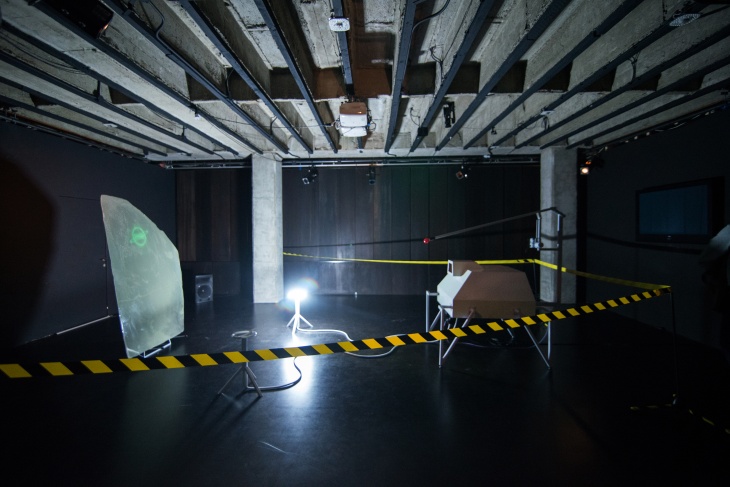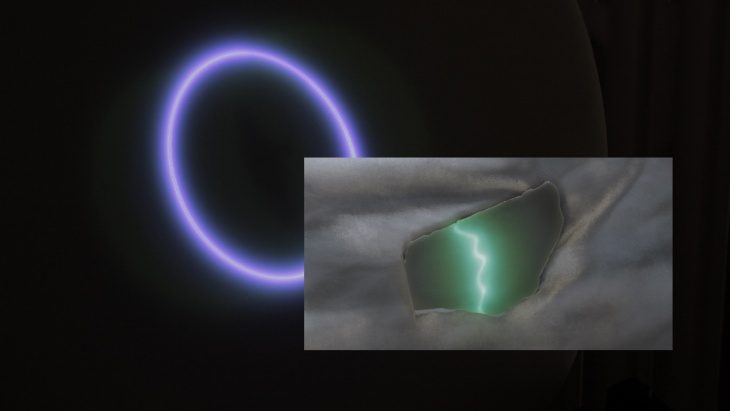Dan Adlešič: Syntrop
An immersive audio-visual installation
November 7 – 17 2018 @ osmo/za, Ljubljana
Syntrop is an immersive audio-visual installation dealing with particular notions from the world of physics. These are derived from the phenomenons of order and chaos or rather syntropy and entropy. Adlešič speculatively interprets the robustness of industrial processing of natural resources and the phenomena of syntropy - the tendency of chaos to form a kind of order by implementing different usages of electronic audio-visual tools and exploring their performative potentials. By addressing the different viscosities of relations among geological phenomena and their contemporary exploitation in the Anthropocene, he engages contemplation about nature's date of expiration, the temporary nature of all organic and inorganic systems and the geophysical, geopolitical and cultural crises.
At the confluence of media art and design, Adlešič establishes a syntropic audio-visual environment which engages the viewer at the sensory level in order to encourage contemplating the complexity of relations and the ontological shadows occupying the contemporary era.

Vsebina
Timeline
- Exhibition opening: November 7 2018 at 8 PM @ osmo/za, Slovenska 54, Ljubljana (8th floor)
- Lecture by Andrej Detela: November 8 2018 at 7 PM @ osmo/za
- Exhibition closing: November 17 2018
Syntrop
Dan Adlešič's installation Syntrop can be understood through the Deleuzian concept of assemblages or through Morton's hyperobjects - objects massively distributed through time and space. »The human hyperobject (the human as geophysical species) became a machine for the generation of hyperobjects«, says Timothy Morton, »hyperobjects are "hyper” in relation to some other entity, whether they are directly manufactured by humans or not."1 A hyperobject can be a black hole, a biosphere, a solar system or can be a direct result of human manufacturing or a result of all other hyperproductive processes of the capitalist machinery (global warming, weather fronts etc.). Hyperobjects are not only related to the ecological crisis, but their mere existence should serve as a reminder to humanity of all other existential crises and dilemmas related to constant transformations and reconfiguration of the political and social space (which never was only human).
We are living during an unstoppable degradation of the planetary ecosystem, pulsating in a dark ecology of radical environmental, social and cultural transformations and we are caught in a loop of emerging order and chaos or syntropy and entropy. "Ecological awareness is a loop because human interference has a loop form, because ecological and biological systems are loops. And ultimately this is because to exist at all is to assume the form of a loop. The loop form of beings means we live in a universe of finitude and fragility, a world in which objects are suffused and surrounded by mysterious hermeneutical clouds of unknowing /…/ Then there are the negative feedback loops that cool down the intensity of positive feedback loops. We encounter them in beings such as global warming, beings that are temporally smeared in such a way that they come in and out of phase with human temporality."2

The Syntrop system is comprised of basic synthesis of audio-visual information, recorded and modulated Syntrop’s electronic vibration and audio devices (laser, flash, speaker), as well as audio samples (Half – Life video game, etc.). The immersive installation can indicate the area of fracture among living and non-living fragments of nature and society at the sensory perceptive level. Therefore, in the prototypic simulation, the process of syntring the "rock" takes place at the edge of perception.
Syntrop is also a test environment, which is not a result of precise scientific research or experimentation at the confluence of science and art, but is rather a consequence of transferring an aesthetical experience to a perceptory level of subject/viewer and object/artpiece; it attempts to encourage the visitor to contemplate the complexity of relations and ontological shadows which define the era we live in. By combining product design and the aesthetics of digital design, Adlešič’s Syntrop forms a kind of dystopical resonator of audio-visual choreographic flow, which is uncovering the landscapes of potential futures.
In Syntrop, Dan Adlešič speculatively interprets the phenomena of hyperobjects through the robustness of industrial procedures over natural resources, exploitation which is a part of a negative feedback loop or an entropic-syntropic loop inside which we are caught. By addressing the different viscosities of relations between geological phenomena and their contemporary exploitation, characteristic of the Anthropocene, he is encouraging contemplation of nature's date of expiration and the temporary nature of all organic and inorganic systems. The exploitation of millions-of-years-old mineral rock by industrial force is portrayed. The spatial configuration includes a laser beam traversing the surface of the rock which contains the phosphorous mineral, capable of holding and emitting light for a short time. Beside the striped laser beam, different audio-visual sources - individually designed sculptural and light objects - set off automated series of audio-visual information.
Syntrop can be perceived as a mental object within a media defined world, establishing it’s boundaries through an audio-visual morphology of here and there, inside a gap between the present and the future or the pre-emptied time and space of post-everything. Syntrop therefore liminally rocks the fragile balance between the fictional and real, the simulation and mimesis – since the designation of their delimitation still represents the foundation of social, cultural, ecological, economical and "hyperobject" order?
Lenka Đorojević
1Timothy Morton, Hyperobjects: Philosophy and Ecology After the End of the World, Minneapolis in London: University of Minnesota Press, Minneapolis, London, 2013, pg. 10.
2Timothy Morton, What is Dark Ecology?, 2015, available at http://www.changingweathers.net/en/episodes/48/what-is-dark-ecology; acessed 31.10.2018.
About the author
Dan Adlešič (1990) is a young Slovenian artist and product designer. He graduated in 2015 at Design Academy Eindhoven in the Contextual Design program with the project Electricity is just like ... WOAH! that was further on presented by Studio Makkink & Bey at the Bi-City Biennale of Urbanism/Architecture in Shenzhen, China and at the Ram Gallery in Rotterdam. In 2016 he presented the project in the form of an exhibition in several galleries across Europe such as the Rossana Orlandi in Milan, the De Witte Dame in Eindhoven, and at the Helsinki Design Museum, and as a performance at the Palais de Tokyo in Paris. That same year he also had a solo show in Kino Šiška, Ljubljana. In 2017 he participated at the Design Biennale BIO25 in Ljubljana for which he created a custom audiovisual installation together with scientist and poet Andrej Detela that was then displayed in the Županova cave.
Author & idea: Dan Adlešič
Curator: Lenka Đorojević
Production: Ljudmila Art and Science Laboratory (Tina Dolinšek)
Special credits: Museum of Architecture and Design - MAO, Andrej Detela, Tit Briški, Alja Lucian, Samson Kamnik, Mizarstvo Vraničar, Tilen Sepič, Polona Torkar, Miha Kelemina and Bojan Stefanović.
The project is supported by MOL – Department for Culture and is part of EASTN-DC Network, which is co-funded by the Creative Europe programme of the European Union.


